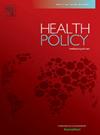在澳大利亚,经济处罚与医院获得性并发症的减少有关
IF 3.4
3区 医学
Q1 HEALTH CARE SCIENCES & SERVICES
引用次数: 0
摘要
背景:医院护理期间的不良事件是全球关注的问题。使用按绩效付费(p4p)解决不安全急症护理的证据尚无定论。目的研究2018年7月1日引入的经济处罚与澳大利亚公立医院13种高优先级医院获得性并发症(HACs)患病率之间的关系。方法使用2014年1月1日至2021年6月30日期间澳大利亚每家公立医院分离(年龄>;17岁)的管理数据,分析季度HAC患病率(每1000多天分离)的变化,采用两种中断时间序列方法:自回归移动平均(ARMA)误差的广义最小二乘法(GLS)和贝叶斯结构化时间序列。结果在研究期间发生了不到2000万次分离,其中947,057例(4.7%)(平均年龄69岁(SD: 18), 48%为女性)至少记录了一次HAC,总体记录了1,263,646例HAC。我们的GLS模型估计,与引入处罚相关的HAC患病率下降了17% (95% CI 12 - 22%)。贝叶斯模型估计下降26%(23 - 29%)。大部分下降发生在12个月的滚动期内。结果表明,与模拟的反事实相比,2018年7月1日至2021年6月30日期间,住院患者经历HAC的人数减少了98,970人。结论:经济处罚的实施与HACs的大幅下降有关。很少有其他的p4p政策与住院伤害的减少有关。未来的研究应检查当地的HAC趋势,并调查可能导致这种变化的其他因素。本文章由计算机程序翻译,如有差异,请以英文原文为准。
Financial penalty associated with a decline in hospital-acquired complications in Australia
Background
Adverse events during hospital care are a global concern. The evidence for addressing unsafe acute care using pay-for-performance (p4p) is inconclusive.
Objective
To examine association between the introduction of a financial penalty on 1 July 2018 and the prevalence of 13 high-priority hospital-acquired complications (HACs) in Australian public hospitals.
Methods
Administrative data on every Australian public hospital separation (age >17 years) between 1 January 2014 and 30 June 2021 was used to analyse changes in quarterly HAC prevalence (per 1000 multi-day separations), standardized to the study population, using two interrupted time series methods: generalized least squares (GLS) with autoregressive moving average (ARMA) errors, and a Bayesian structured time series.
Results
Just under 20 million separations took place over the study period with 947,057 (4.7%) (mean age 69 (SD: 18), 48% female) recording at least one HAC and 1,263,646 HACs overall. Our GLS model estimated a decline of 17% (95% CI 12 – 22%) in HAC prevalence associated with the introduction of the penalty. The Bayesian model estimated a 26% (23 – 29%) decline. Most of the decline occurred during a 12-month roll-in period. Results suggest that 98,970 fewer inpatients experienced a HAC from 1 July 2018 to 30 June 2021 compared to the modelled counterfactual.
Conclusions
Implementation of a financial penalty was associated with a substantial decline in HACs. Few other p4p policies have been associated with reductions in inpatient harm. Future research should examine local HAC trends and investigate what other factors may have contributed to the change.
求助全文
通过发布文献求助,成功后即可免费获取论文全文。
去求助
来源期刊

Health Policy
医学-卫生保健
CiteScore
6.40
自引率
6.10%
发文量
157
审稿时长
3-8 weeks
期刊介绍:
Health Policy is intended to be a vehicle for the exploration and discussion of health policy and health system issues and is aimed in particular at enhancing communication between health policy and system researchers, legislators, decision-makers and professionals concerned with developing, implementing, and analysing health policy, health systems and health care reforms, primarily in high-income countries outside the U.S.A.
 求助内容:
求助内容: 应助结果提醒方式:
应助结果提醒方式:


